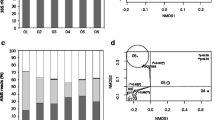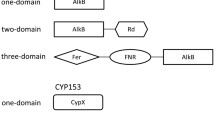Abstract
The diversity of alkB-related alkane hydroxylase sequences and the relationship between alkB gene expression and the hydrocarbon contamination level have been investigated in the chronically polluted Etang-de-Berre sediments. For this purpose, these sediments were maintained in microcosms and submitted to a controlled oil input miming an oil spill. New degenerated PCR primers targeting alkB-related alkane hydroxylase sequences were designed to explore the diversity and the expression of these genes using terminal restriction fragment length polymorphism fingerprinting and gene library analyses. Induction of alkB genes was detected immediately after oil addition and their expression detected only during 2 days, although the n-alkane degradation was observed throughout the 14 days of incubation. The alkB gene expression within triplicate microcosms was heterogeneous probably due to the low level of alkB transcripts. Moreover, the alkB gene expression of dominant OTUs has been observed in unoiled microcosms indicating that the expression of this gene cannot be directly related to the oil contamination. Although the dominant alkB genes and transcripts detected were closely related to the alkB of Marinobacter aquaeolei isolated from an oil-producing well, and to alkB genes related to the obligate alkanotroph Alcanivorax borkumensis, no clear relationship between the oil contamination and the expression of the alkB genes could be established. This finding suggests that in such coastal environments, alkB gene expression is not a function relevant enough to monitor bacterial response to oil contamination.



Similar content being viewed by others
References
Berdie L, Grimalt JO, Gjessing ET (1995) Hydrocarbons, alcohols and sterols in the dissolved + colloidal and particulate phases of the waters from a dystrophic lake, Skjervatjern lake (Norway). Water Res 29:2017–2030
Bordenave S, Goñi-Urriza MS, Caumette P, Duran R (2007) Effects of heavy fuel oil on the bacterial community structure of a pristine microbial mat. Appl Environ Microbiol 73:6089–6097
Grötzschel S, Köster J, Abed RMM, De Beer D (2002) Degradation of petroleum model compounds immobilized on clay by a hypersaline microbial mat. Biodegradation 13:273–283
Hamamura N, Fukui M, Ward DM, Inskeep WP (2008) Assessing soil microbial populations responding to crude-oil amendment at different temperatures using phylogenetic, functional gene (alkB) and physiological analyses. Env Sci Tec 42:7580–7586
Han J, Calvin M (1969) Hydrocarbon distribution of algae and bacteria, and microbiological activity in sediments. P Natl Acad Sci USA 64:436–443
Head IM, Jones DM, Röling WF (2006) Marine microorganisms make a meal of oil. Nat Rev Microbiol 4:173–182
Heiss-Blanquet S, Benoit Y, Maréchaux C, Monot F (2005) Assessing the role of alkane hydroxylase genotypes in environmental samples by competitive PCR. J Appl Microbiol 99:1392–1403
Hornafius J, Quigley D, Luyendyk B (1999) The world’s most spectacular marine hydrocarbon seeps (Coal Oil Point, Santa Barbara Channel, California): quantification of emissions. J Geophys Res-Oceans 104:20703–20711
Jacquot F, Le Dréau Y, Doumenq P, Munoz D, Guiliano M, Imbert G, Mille G (1999) The origins of hydrocarbons trapped in the Lake of Berre sediments. Chemosphere 39:1407–1419
Kloos K, Munch JC, Schloter M (2006) A new method for the detection of alkane-monooxygenase homologous genes (alkB) in soils based on PCR hybridization. J Microbiol Methods 66:486–496
Kok M, Oldenhuis R, van der Linden MPG, Raatjes P, Kingma J, van Lelyveld PH et al (1989) The Pseudomonas oleovorans alkane hydroxylase gene, sequence and expression. J Biol Chem 264:5435–5441
Kuhn E, Bellicanta GS, Pellizari VH (2009) New alk genes detected in Antarctic marine sediments. Environ Microbiol 11:669–673
Li L, Liu X, Yang W, Xu F, Wang W, L Feng et al (2008) Crystal structure of long-chain alkane monooxygenase (LadA) in complex with coenzyme FMN: unveiling the long-chain alkane hydroxylase. J Mol Biol 376:453–465
Lieberman RL, Rosenzweig AC (2004) Crystallographic trapping of a precatalytic enzyme complex provides new insight into dioxygen activation at a mononuclear copper center. Crit Rev Bioch Mol Biol 39:147–164
Maeng JH, Sakai Y, Tani Y, Kato N (1996) Isolation and characterization of a novel oxygenase that catalyzes the first step of n-alkane oxidation in Acinetobacter sp strain M-1. J Bacteriol 178:3695–3700
Márquez MC, Ventosa A (2005) Marinobacter hydrocarbonoclasticus (Gauthier 1992) and Marinobacter aquaeolei (Nguyen et al. 1999) are heterotypic synonyms. Int J Syst Evol Microbio 55:1349–1351
Navarrete A, Urmeneta J, Cantu JM, Vegas E, White DC, Guerrero R (2004) Signature lipid biomarkers of microbial mats of the EbroDelta (Spain), Camargue and Etang de Berre (France): an assessment of biomass and activity. Ophelia 58:175–188
Païssé S, Coulon F, Goñi-Urriza M, Peperzak L, McGenity TJ, Duran R (2008) Structure of bacterial communities along a hydrocarbon contamination gradient in a coastal sediment. FEMS Microbiol Ecol 66:295–305
Païssé S, Goñi-Urriza M, Coulon F, Duran R (2010) How a bacterial community originating from a contaminated coastal sediment responds to an oil input. Microbial Ecol 60:394–405
Palmroth MRT, Koskinen PEP, Kaksonen AH, Münster U, Pichtel J, Puhakka JA (2007) Metabolic and phylogenetic analysis of microbial communities during phytoremediation of soil contaminated with weathered hydrocarbons and heavy metals. Biodegradation 18:769–782
Sariaslani FS, Omer CA (1992) Actinomycete cytochrme P-450 involved in oxidative metabolism: biochemistry and molecular biology. Crit Rev Plant Sci 11:1–16
Schloss PD, Handelsman J (2008) A statistical toolbox for metagenomics: assessing functional diversity in microbial communities. BMC Bioinforma 9:34
Seewald J (2003) Organic–inorganic interactions in petroleum-producing sedimentary basins. Nature 426:327–333
Sei K, Mori K, Kohno T, Maki H (2003) Development and application of PCR primers for monitoring alkane-degrading bacteria in seawater microcosm during crude oil degradation process. J Chem Eng Jpn 36:1185–1193
Smits THM, Röthlisberger M, Witholt B, van Beilen JB (1999) Molecular screening for alkane hydroxylase genes in Gram-negative and Gram-positive strains. Environ Microbiol 1:307–318
Stan-Lotter H (1999) Marinobacter aquaeolei sp. nov., a halophilic bacterium isolated from a Vietnamese oil-producing well. Int J Syst Bacteriol 49:367–375
Throne-Holst M, Markussen S, Winnberg A, Ellingsen TE, Kotlar HK, Zotchev SB (2006) Utilization of n-alkanes by a newly isolated strain of Acinetobacter venetianus: the role of two AlkB-type alkane hydroxylases. Appl Microbiol Biotechnol 72:353–360
van Beilen JB, Funhoff EG (2007) Alkane hydroxylases involved in microbial alkane degradation. Appl Microbiol Biotechnol 74:13–21
van Beilen JB, Wubbolts MG, Witholt B (1994) Genetics of alkane oxidation by Pseudomonas oleovorans. Biodegradation 5:161–174
van Beilen J, Panke S, Lucchini S, Franchini A, Röthlisberger M, Witholt B (2001) Analysis of Pseudomonas putida alkane degradation gene clusters and flanking insertion sequences: evolution and regulation of the alk genes. Microbiology 147:1621–1630
van Beilen JB, Smits THM, Whyte LG, Schorcht S, Röthlisberger M, Plaggemeier T, Engesser K-H, Witholt B (2002) Alkane hydroxylase homologues in Gram-positives strains. Environ Microb 4:676–682
van Beilen JB, Li Z, Duetz WA, Smits THM, Witholt B (2003) Diversity of alkane hydroxylase systems in the environment. Oil & Gas Sci Technol 58:427–440
van Beilen JB, Funhoff EG, van Loon A, Just A, Kaysser L, Bouza M et al (2006) Cytochrome P450 alkane hydroxylases of the CYP153 family are common in alkane-degrading eubacteria lacking integral membrane alkane hydroxylases. Appl Environ Microbiol 72:59–65
Vomberg A, Klinner U (2000) Distribution of alkB genes within n-alkane-degrading bacteria. J Appl Microb 89:339–348
Wang L, Wang W, Lai Q, Shao Z (2010a) Gene diversity of CYP153A and AlkB alkane hydroxylases in oil-degrading bacteria isolated from the Atlantic Ocean. Environ Microbiol 12:1230–1242
Wang W, Wang L, Shao Z (2010b) Diversity and abundance of oil-degrading bacteria and alkane hydroxylase (alkB) genes in the subtropical seawater of Xiamen Island. Microb Ecol 60:429–439
Whyte LG, Greer CW, Inniss WE (1996) Assessment of the biodegradation potential of psychrotrophic microorganisms. Can J Microbiol 42:99–106
Whyte LG, Schultz A, van Beilen JB, Luz AP, Pellizari VH, Labbe D, Greer CW (2002) Prevalence of alkane monooxygenase genes in Arctic and Antarctic hydrocarbon-contaminated and pristine soils. FEMS Microbiol Ecol 41:141–150
Widdel F, Rabus R (2001) Anaerobic biodegradation of saturated and aromatic hydrocarbons. Curr Opin Biotech 12:259–276
Yakimov MM, Golyshin PN, Lang S, Moore ERB, Abraham W-R, Lünsdorf H, Timmis KN (1998) Alcanivorax borkumensis gen. nov., sp. nov., a new, hydrocarbon-degrading and surfactant-producing marine bacterium. Int J Syst Bacteriol 48:339–348
Yakimov MM, Giuliano L, Denaro R, Crisafi E, Chernikova TN, Abraham W-R, Luensdorf H, Golyshin PN et al (2004) Thalassolituus oleivorans gen. nov., sp. nov., a novel marine bacterium that obligately utilizes hydrocarbons. Int J Syst Evol Microbio 54:141–148
Acknowledgments
This work was funded by the European Community Project FACEiT [(STREP-grant no. 018391 (GOCE)]. We would like to thank all partners of the FACEiT project for their useful discussions. We acknowledge the financial support by the Aquitaine Regional Government Council (France), the Ministère de l’Ecologie et du Développement Durable (MEDD-PNETOX project no. CV04000147), and the ANR (DHYVA project, no. 06SEST09).
Author information
Authors and Affiliations
Corresponding author
Rights and permissions
About this article
Cite this article
Paisse, S., Duran, R., Coulon, F. et al. Are alkane hydroxylase genes (alkB) relevant to assess petroleum bioremediation processes in chronically polluted coastal sediments?. Appl Microbiol Biotechnol 92, 835–844 (2011). https://doi.org/10.1007/s00253-011-3381-5
Received:
Revised:
Accepted:
Published:
Issue Date:
DOI: https://doi.org/10.1007/s00253-011-3381-5




